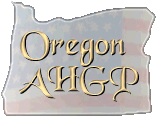Baker City's Manufactured Gas Plant Located off Washington
By Phyllis Badgley
Directly across from Baker Garage in the 1700 block
of Washington Street, an alley extends about 200 feet South. In
former years a brick building and a huge round metal tank (above
ground) were located there.
Longtime Baker City resident Virgil Wunder recalled the red brick
building being part of a coal gas operation with the huge cistern
storage tank nearby at ground level.
Roland Campbell, retired city recorder, concurred that theory. He at
one time lived nearby the facility. Campbell stated that the Eastern
Oregon Light and Power Co. used the facility to generate gas for
heat and power.
Coal with gas removed produced a by product "coke" which was used as
fuel in some homes.
The gas storage tank was in close proximity to the brick building
that housed control gauges. An operator kept watch on gas pressure
output from the above ground steel tank. The mechanically designed
tank had steel balls on a track that allowed the structure to gain
or decrease height.
Manufactured gas from the facility served some of the Main Street
businesses, lines also extended North on 1st and 2nd streets and a
short way South on Dewey Street. Campbell stated that City Hall had
early day gas light fixtures before converting to electricity. The
manufactured gas cistern was dismantled in the mid 30's by McKim
Foundry and Machine Shop.
Glen Bates, board director for Oregon Trail Electric Co-op told me
of discussions he had with former Eastern Oregon Light and Power Co.
officials Leon Gray and Bill Riordan. In late 1920's and early 30s
the coal-gas operation was not showing large financial returns for
the company. Consequently these two men were given the task of
convincing Main Street merchants to convert to electricity. Touting
that electricity was definitely the key to the future, Gray and
Riordan successfully pushed sales of electric stoves and water
heaters.
Longtime Baker City residents will recall as I do, officers and
department heads of E. O. L. & P. during 30s-40s. In addition to
those mentioned, familiar names were Lottridge, King, Wiggins,
Lyman, Lanning, Enright, Reider, and Comstock.
Bates explained to me that power sources were originally designed to
aid the mining industry. When excess occurred, lines were built to
carry electricity to additional customers. Water powered electric
plants were established by E. O. L. & P. Co. as a network between
Rock Creek, Bourne, and Fremont. One former power plant operator.
Henry "Hank" Potts still lives in La Grande.
With unlimited electric power available homes of the 1930s began to
accumulate numerous appliances. Heating pads gained popularity.
Electric curling irons enabled mademoiselle to obtain a "marcell" at
home. Electric mixers provided ease in preparing cakes, mashed
potatoes, and juices. Farmers utilized electricity for pumps and
milking machines.
My Aunt in that era had a "modern" appliance that fascinated me. It
was an ironing mangle. This device allowed the operator to iron
while seated. Clothing was fed through a heated roller to diffuse
wrinkles. Definitely a step ahead of commonplace hand held irons.
During the Depression years, economy was stressed in our home. We
were taught to "turn off the lights" when not in use-a habit still
ingrained.
The Power Co. as a marketing tool, sponsored cooking schools to
teach housewives to cook more effectively with electricity. After
many years of service, E. O. L. & P. Co. sold to Calif-Pacific
Utilities.
Loy Wisdom, early day E. O. L. & P. employee, maintained volumes of
history of the power company. Unfortunately these historic documents
were lost in a disastrous fire, when power company headquarters in
the Rand building at First and Washington Streets was consumed by
fire in the mid 1980s. Presently our locally owned utility OTEC
serves us from 4005 23rd St., Baker City.
Today with endless uses of electricity we cannot imagine our world
without this convenience. Thank You, Thos. Edison!!
Printed here with permission of Record Courier
